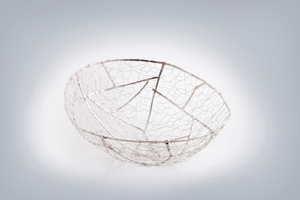Aiken Standard Article – June 19, 2015
ARTS AND HUMANITIES: State museum celebrates ‘Carolina Makers’
by Dr. Tom Mack
When does craft become art? The traditional distinction between art and craft involves differentiating between what is decorative and perhaps elevating and what is functional. Thus, a painting might be considered “art” and a ceramic bowl could be labeled “craft.”
Yet, this distinction fails to account for those functional items that transcend their intended purpose as in the case of a clay vessel that can be both a practical container and an object of beauty. In the final analysis, one might argue that the definition of “art” can be expanded to include any end-product of the creative process, regardless of the chosen medium.
Visitors to the South Carolina State Museum currently have ample opportunity to grapple with these issues as they examine a host of unique, largely handmade objects by twenty-seven creative individuals living and working in our state. Entitled “Carolina Makers,” this large-scale exhibition of furniture, metalwork, textiles and musical instruments intentionally blurs the lines between craft and art, between artisan and artist.
Take, for example, one of the most stunning pieces in the furniture category, a rocking chair by Sean Ahern. As one’s country cousin might assert, “This ain’t your grannie’s rocker.” Indeed, Ahern’s chair aspires to the condition of sculpture; the iron runner curves upward to form the arms, which are capped to resemble tendrils. It is as if Ahern had fashioned a throne for the Pumpkin King, its back and seat of cherry, its metal frame echoing the orange fruit’s aggressive vines.
A graduate of the Atlanta College of Art, Sean Ahern must have, at some point, come under the spell of art nouveau with its sinuous lines inspired by vegetal imagery; and that influence persists to this day as he continues to forge his pieces at Ahern’s Anvil in Charleston, info@ahernsanvil.com.
Also in the metalworking category – but on a much smaller scale – are the silver pieces by Kaminer Haislip, an Aiken native who now runs her own studio in downtown Charleston, info@kaminerhaislip.com. Her work also merges the functional and the decorative, and that fusion is reflected in the trajectory of her career, which began in her family’s hardware store and culminated in her earning a Master of Fine Arts degree in jewelry and metalwork at Winthrop University.
In the current show are two of a series of three cylindrical boxes by Haislip: Chorus II and III. The titles allude to the fact that the artisan/artist has attached vertically to each lid the silhouette of a bird, its beak open in full-throated song. Haislip seems particularly partial to our avian friends since her creative output is also represented in the current show by a “nest bowl” constructed of silver filaments of varying thicknesses, interlaced to resemble the twigs and other organic material birds use to assemble the places they build to rear their young.
Birds are, of course, among nature’s most ardent recyclers; and so are a number of textile artists in the present exhibition. Take, for example, Rusty Sox, who is not only the Senior Manager of Program Development at the South Carolina Arts Commission but also the proprietor of Titanic Alley, which specializes in the making of bow ties by using secondhand materials: www.titanicalley.com.
Named for a tenement neighborhood just off Elmwood Avenue in Columbia, Titanic Alley is both a reflection of Sox’s penchant for good workmanship and an echo of a bygone era. The bow tie is making a comeback today, and the five ties fashioned by Rusty Sox for the state museum are excellent examples of what might be described as wearable art.
In the final analysis, that may be the essential appeal of the many items in this major exhibition. The bow ties, braces, purses, scarves and hats are wearable art; the handcrafted guitars, violins and mandolins are playable art; the tables, sideboards and chairs serve a function, but they are also a joy to behold.
Those interested in discovering just how artificial is the traditional distinction between what is craft and what is art are encouraged to visit the South Carolina State Museum to meander through the first-floor gallery devoted to “Carolina Makers.” The show runs through Feb. 7.
A recipient of the Governor’s Award in the Humanities, Dr. Tom Mack holds the rank of Distinguished Professor Emeritus at USC Aiken. His books “Circling the Savannah” and “Hidden History of Aiken County” offer a colorful introduction to this region of the country.
Architectural Digest Daily AD – May 12, 2015
REESE WITHERSPOON LAUNCHES A SOUTHERN-INSPIRED LIFESTYLE BRAND
Text by Colleen Egan
Reese Witherspoon’s latest role isn’t as an actress, but as an entrepreneur: The Oscar winner has recently launched Draper James, a clothing and lifestyle brand inspired by her Southern upbringing.
Named for her grandparents, Dorothea Draper and William James Witherspoon, the brand offers clothing and accessories as well as home items such as throws and mint-julep cups. Draper James has also commissioned items from Southern artisans and stores, including a magnolia-shaped sterling-silver bowl by Charleston, South Carolina, silversmith Kaminer Haislip and a set of linen cocktail napkins embroidered with sayings like “Top Me Off” by Savannah, Georgia’s Number Four Eleven. The products are available online, and a brick-and-mortar Draper James store will open in Nashville this fall.
http://www.architecturaldigest.com/blogs/daily/2015/05/reese-witherspoon-draper-james
The Post & Courier – May 7, 2015
Reese Witherspoon recruits Charleston businesswoman for new fashion line
by Warren L. Wise
Actress Reese Witherspoon launched her fashion and lifestyle website, Draper James, this week. The line includes a silver piece made by Charleston silversmith Kaminer Haislip.
Southern-born actress Reese Witherspoon turned to help in Charleston before she launched her new Draper James sportswear and lifestyle label online earlier this week.
Trying to connect with as many Southern sources as possible, she recruited silversmith Kaminer Haislip for one of her home and entertaining items.
Haislip, from her studio on St. Philip Street, provided a hand-made sterling silver bowl in the shape of a magnolia blossom. It’s priced at $400. “I love to do unusual and unique projects,” she said. “This was a fun project to work on with them. I’m excited they are promoting Southern lifestyle brands. It’s a really good fit for my work.”
Witherspoon’s company also tapped Hanna Nation Seabrook for stationery items.
Seabrook, who lived in Charleston for several years but now calls Kentucky home, provided design work for paper products, such as notecards and notepads, and creative direction for some of the home and gifting goods.
“Being included in this strong Southern line is such an honor,” she said.
The name for Witherspoon’s line is derived from her maternal grandparents, Dorothea Draper and William James Witherspoon.



